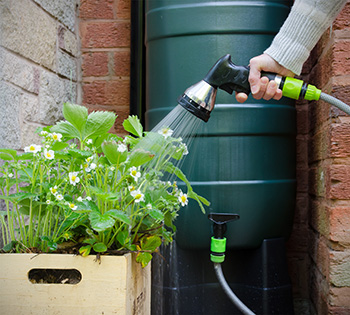Safe Use of Rain Barrel Water

Using a rain barrel for water conservation is a great practice, but it is best to understand how to do so safely.
Rain barrels are an excellent way to conserve water (if you want to know how to build a rain barrel, check out our guide). While rain barrel water is safe to use on ornamentals and lawns, you need to take precautions when deciding whether to use it on your fruit and vegetable garden. Rain barrel water has been shown to contain chemicals and pathogens from runoff or from pathogenic growth over time in standing water.
Consider these factors before using rain barrel water:
How does roofing influence rain barrel water?
- Different types of shingles or other materials used for roofing can leach chemicals, such as lead, into the water that runs over its surface during a rainstorm. Chemical reactions can also occur between the water and the roofing material which can cause water molecules to bind to substances which will end up in your rain barrel.
- Consider using your rain barrel water only for ornamentals, trees and lawns rather than your fruit and vegetable garden if you are selling your produce as part of a regulated business. Metals and other harmful substances from harvested water can end up in irrigated plants and can accumulate in edible portions causing a potential human health risk.
- Pathogens, such as bacteria, viruses and parasites from animal waste (e.g., bird droppings), can get washed into your rain barrel from your roof and rapidly multiply. Consider using a covered rain barrel with a direct catchment.
How are you watering your garden?
- It is best to use rain barrel water on ornamentals, trees and lawns, but if you choose to use rain barrel water on your vegetable and fruit plants, the safest way to do it is by watering the soil and not the plant itself. Direct contact of rain barrel water on the harvestable portion of the crop could result in chemical or pathogenic contamination.
- If rain barrel water is used to irrigate edible plants, wash the food thoroughly with potable water before consuming any part of the plant to reduce the risk of ingestion of potentially harmful pathogens or chemicals.
How are you watering your produce garden?
- The best way to water your produce garden is with water from a municipal source. If you do not have a municipal source, be sure to test your ground water or surface water for the presence of generic E. coli before using it for irrigation. You can do so by getting a water test kit from your local health unit or county extension office. It is possible to use surface water from a rain barrel, a pond, spring or other surface water source, but this type of water does increase your risk of exposure to chemical or pathogen contamination.
- Even if you do not use rain barrel water for irrigation when growing edible plants, make sure to thoroughly clean the produce by scrubbing them under running potable water. Potable water comes from a municipal source or from a well that tested negative for detectable generic E. coli. Always thoroughly clean your produce, no matter where it comes from, even if you do not plan to eat the skin. On produce with tough skin, the use of a scrubbing brush to remove dirt and debris is useful.
While rain barrel water is safe to use on ornamentals and lawns, consider these precautions when deciding whether to use it on your fruit and vegetable garden. Contact your local extension office for more information. See the following articles below to learn more about the risks associated with using rain water for drinking water and produce.
RESOURCES:
Bakacs, M., Haberland, M., & Yergeau, S. (2013). Rain barrels part IV: Testing and applying harvested water to irrigate a vegetable garden FS1218. Rutgers New Jersey Agricultural Experiment Station Cooperative Extension. Retrieved from https://njaes.rutgers.edu/fs1218/
Balkhair, K. S., & Ashraf, M. A. (2016). Field accumulation risks of heavy metals in soil and vegetable crop irrigated with sewage water in western region of Saudi Arabia. Saudi Journal of Biological Sciences, 23(1), S32–S44. https://doi.org/10.1016/j.sjbs.2015.09.023
Clark, S. E., Steele, K. A., Spicher, J., Siu, C. S., Lalor, M. M., Pitt, R., & Kirby, J. T. (2008). Roofing materials’ contributions to storm-water runoff pollution. Journal of Irrigation and Drainage Engineering, 134(5), 638–645. https://doi.org/10.1061/(ASCE)0733-9437(2008)134:5(638)
DeBusk, K. M., Hunt, W. F., Osmond, D. L., & Cope, G. W. (2009). Water quality of rooftop runoff: Implications for residential water harvesting systems. North Carolina Cooperative Extension. Retrieved from https://content.ces.ncsu.edu/water-quality-of-rooftop-runoff
Haberland, M., Bakacs, M., & Yergeau, S. (2013). An investigation of the water quality of rainwater harvesting systems. Journal of the NACAA, 6(1). Retrieved from https://www.nacaa.com/journal/index.php?jid=205
Mangiafico, S. S., & Obropta, C. C. (2011). Rooftop rainwater harvesting for plant irrigation II: Water quality and horticultural considerations FS1165. Rutgers New Jersey Agricultural Experiment Station Cooperative Extension, 4. Retrieved from https://njaes.rutgers.edu/pubs/publication.php?pid=FS1165
Tom, M., Fletcher, T. D., & McCarthy, D. T. (2014). Heavy metal contamination of vegetables irrigated by urban stormwater: A matter of time? PLoS ONE, 9(11). https://doi.org/10.1371/journal.pone.0112441
By Sarah Spangler, CEA - Agriculture/Water Quality, Washington County, John Pennington, Instructor - Water Quality Educator, Agriculture and Natural Resources and Dr. Amanda Philyaw Perez, Assistant Professor.